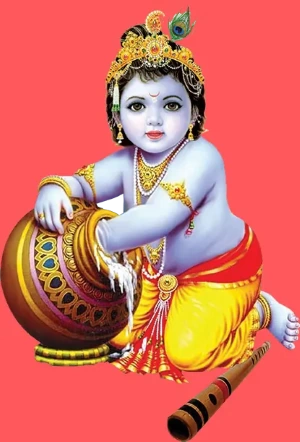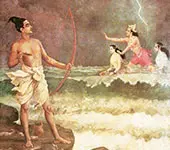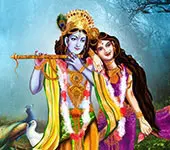How, What, Which, And Why Of His Avataras

Transcript
(Click here to read more)
Out of the six questions that the rishis of Naimisharanya asked Suta, we have covered already three. What is the greatest goal? How to achieve this? Why has Bhagawan now taken avatara as the son of Devaki and Vasudeva? Now the fourth question - ЯццЯцИЯЦЇЯц» ЯцЋЯц░ЯЦЇЯц«ЯцЙЯцБЯЦЇЯц»ЯЦЂЯцдЯцЙЯц░ЯцЙЯцБЯц┐ ЯцфЯц░Яц┐ЯцЌЯЦђЯццЯцЙЯцеЯц┐ ЯцИЯЦѓЯц░Яц┐ЯцГЯц┐ЯцЃ ЯЦц ЯцгЯЦЇЯц░ЯЦѓЯц╣Яц┐ ЯцеЯцЃ ЯцХЯЦЇЯц░ЯцдЯЦЇЯцдЯцДЯцЙЯцеЯцЙЯцеЯцЙЯцѓ Яц▓ЯЦђЯц▓Яц»ЯцЙ ЯцдЯцДЯццЯцЃ ЯцЋЯц▓ЯцЙЯцЃ ЯЦЦ Tell us about his leelas. What is leela? How is leela different fro....
Transcript
(Click here)
Out of the six questions that the rishis of Naimisharanya asked Suta, we have covered already three.
What is the greatest goal?
How to achieve this?
Why has Bhagawan now taken avatara as the son of Devaki and Vasudeva?
Now the fourth question -
ЯццЯцИЯЦЇЯц» ЯцЋЯц░ЯЦЇЯц«ЯцЙЯцБЯЦЇЯц»ЯЦЂЯцдЯцЙЯц░ЯцЙЯцБЯц┐ ЯцфЯц░Яц┐ЯцЌЯЦђЯццЯцЙЯцеЯц┐ ЯцИЯЦѓЯц░Яц┐ЯцГЯц┐ЯцЃ ЯЦц
ЯцгЯЦЇЯц░ЯЦѓЯц╣Яц┐ ЯцеЯцЃ ЯцХЯЦЇЯц░ЯцдЯЦЇЯцдЯцДЯцЙЯцеЯцЙЯцеЯцЙЯцѓ Яц▓ЯЦђЯц▓Яц»ЯцЙ ЯцдЯцДЯццЯцЃ ЯцЋЯц▓ЯцЙЯцЃ ЯЦЦ
Tell us about his leelas.
What is leela?
How is leela different from common acts?
In common acts, an effort is involved.
Whatever is done in a joyful mood, without effort, casually is called leela.
ЯцЁЯцеЯцЙЯц»ЯцЙЯцИЯЦЄЯце Яц╣Яц░ЯЦЇЯциЯцЙЯццЯЦЇЯцЋЯЦЇЯц░Яц┐Яц»Яц«ЯцЙЯцБЯцЙ ЯцџЯЦЄЯциЯЦЇЯцЪЯцЙ Яц▓ЯЦђЯц▓ЯцЙЯЦц
His leelas are so many.
His leelas to benefit the world are so many.
They have benefited the world directly and indirectly as well.
Each avatara has a central theme associated with it.
They are not even just about the leelas of his avatara.
Everything, creation of the universes, their maintenance, dissolution they are all his leelas only.
It is not that they have not been told before.
They have been told before also.
By scholars such as Narada.
But we are not satisfied.
We want to hear them again and again.
The tongue can be satisfied.
The stomach can be satisfied.
But the ears eager to hear about his leelas can never be satisfied.
Not just about Krishnavatara, we want to hear about the other avataras also.
ЯцЁЯцЦЯцЙЯцќЯЦЇЯц»ЯцЙЯц╣Яц┐ Яц╣Яц░ЯЦЄЯц░ЯЦЇЯцДЯЦђЯц«ЯцеЯЦЇЯцеЯцхЯццЯцЙЯц░ЯцЋЯцЦЯцЙЯцЃ ЯцХЯЦЂЯцГЯцЙЯцЃ
Яц▓ЯЦђЯц▓ЯцЙ ЯцхЯц┐ЯцдЯцДЯццЯцЃ ЯцИЯЦЇЯцхЯЦѕЯц░Яц«ЯЦђЯцХЯЦЇЯцхЯц░ЯцИЯЦЇЯц»ЯцЙЯццЯЦЇЯц«Яц«ЯцЙЯц»Яц»ЯцЙ
There can be four questions related to avataras.
How did a particular avatara occur?
What was the form of the avatara?
Which is the place where the avatara took place?
Why did Bhagawan take that avatara?
Hearing the answers to these questions itself will benefit the listener.
What were the means with which Bhagawan took these avataras?
Atmamaya, his own maya shakti, by his own desire.
He was not under any compulsion.
He decided to take avatara.
He took using his own maya shakti.
He was not dependent on any external agency for this.
Rishis are addressing Suta ЯцДЯЦђЯц«ЯцеЯЦЇ, intelligent, wise.
Only the intelligent can understand the intricacies of his avataras even partially.
ЯцхЯц»Яцѓ ЯццЯЦЂ Яце ЯцхЯц┐ЯццЯЦЃЯцфЯЦЇЯц»ЯцЙЯц« ЯцЅЯццЯЦЇЯццЯц«ЯцХЯЦЇЯц▓ЯЦІЯцЋЯцхЯц┐ЯцЋЯЦЇЯц░Яц«ЯЦЄ
Яц»ЯцџЯЦЇЯцЏЯЦЃЯцБЯЦЇЯцхЯццЯцЙЯцѓ Яц░ЯцИЯцюЯЦЇЯцъЯцЙЯцеЯцЙЯцѓ ЯцИЯЦЇЯцхЯцЙЯцдЯЦЂ ЯцИЯЦЇЯцхЯцЙЯцдЯЦЂ ЯцфЯцдЯЦЄ ЯцфЯцдЯЦЄ
There are only three instances that can make you stop listening to the stories of his leelas.
One - there is something better to do.
That's not possible.
There is nothing better than this.
Two - his stories are no longer available.
That is also not possible.
To the discerning, they are also available.
Three - lack of interest.
Nothing can be done about it.
There are people who don't enjoy music.
Can you make them enjoy music?
No.
You will come to know whether you like it or not only if you listen to it.
You mug up as many recipes as you want.
Unless you actually cook and taste the dish you will not know whether you like it or not.
The dish may be there sitting in front of you.
You may be seeing it with your eyes.
But unless that dish comes in contact with your taste buds, you will not know whether you savor it or not.
In the same way, you may have heard so much about Bhagavata.
But you have to actually listen to it.
Then only you will know, whether you have it in you, whether you can enjoy it.
But those who have an interest in Bhagawan, every step they become more and more interested, they enjoy more and more.
They just don't get satisfied enough.
As ignorance gets removed from your mind more and more, you start enjoying it more and more
His leelas are his vikrama.
Vikrama means they are about his action.
They are about Bhagawan in action.
The 20th shloka
ЯцЋЯЦЃЯццЯцхЯцЙЯцеЯЦЇ ЯцЋЯц┐Яц▓ ЯцхЯЦђЯц░ЯЦЇЯц»ЯцЙЯцБЯц┐ ЯцИЯц╣ Яц░ЯцЙЯц«ЯЦЄЯцБ ЯцЋЯЦЄЯцХЯцхЯцЃ
ЯцЁЯццЯц┐Яц«Яц░ЯЦЇЯццЯЦЇЯц»ЯцЙЯцеЯц┐ ЯцГЯцЌЯцхЯцЙЯцеЯЦЇ ЯцЌЯЦѓЯцбЯцЃ ЯцЋЯцфЯцЪЯц«ЯцЙЯцеЯЦЂЯциЯцЃ
We want to listen to all that he did.
All that the kapatamanusha did.
He is doing kapatya with us.
He is cheating.
He makes it look like he is a human being.
But whatever he does is superhuman.
His adventures are along with Rama, Balarama.
This is interesting.
Balarama is an aveshavatara of Bhagawan.
Bhagawan is purnavatara.
At the same time, at the same place both acting together, an aveshavatara and an avatara acting together, performing miracles has never happened before.
There was an encounter between Parashurama and Shree Rama.
But they have not acted together.
Here, Krishna and Balarama have done so many things together.
There is something about the divya nama keshava being used here.
In Narasimha Avatara, Bhagawan killed Hiranyakashipu, a devotee of Brahma.
In Ramavatara, Bhagawan killed Ravana, a devotee of Shiva.
But in Krishnavatara he didn't do anything of that sort.
ЯцЋЯцХЯЦЇЯцџ ЯцѕЯцХЯцХЯЦЇЯцџ ЯцЋЯЦЄЯцХЯЦї
ЯцЋЯЦЄЯцХЯц»ЯЦІЯц░ЯцхЯцѓ ЯцЁЯц«ЯЦЃЯццЯцѓ Яц»ЯцИЯЦЇЯц«ЯцЙЯцдЯц┐ЯццЯц┐ ЯцЋЯЦЄЯцХЯцхЯцЃ
ЯцЋЯцЃ means Brahma.
ЯцѕЯцХЯцЃ is Shiva.
Together they are ЯцЋЯЦЄЯцХЯЦї.
Bhagawan is like nectar for them in this avatara.
He did nothing in this avatara that they may feel bad about.
So this is the fifth question, tell us about what all did he do?
Recommended for you
What Does It Mean To Be Intelligent?

What Does It Mean To Be Intelligent? Children's Story....
Click here to know more..Mantra From Atharva Veda For Happiness And Comfort

Яц»ЯцЙЯцеЯц┐ ЯцеЯцЋЯЦЇЯциЯццЯЦЇЯц░ЯцЙЯцБЯц┐ ЯцдЯц┐ЯцхЯЦЇЯц»ЯцеЯЦЇЯццЯц░Яц┐ЯцЋЯЦЇЯциЯЦЄ ЯцЁЯцфЯЦЇЯцИЯЦЂ ЯцГЯЦѓЯц«ЯЦї Яц»ЯцЙЯцеЯц┐ ЯцеЯцЌЯЦЄЯциЯЦЂ ЯцдЯц....
Click here to know more..Raghava Stuti

aanjaneyaarchitam jaanakeeranjanam bhanjanaaraativri'ndaarakanjaakhilam. kanjanaanantakhadyotakanjaarakam ganjanaakhand'alam khanjanaaksham bhaje.....
Click here to know more..
English Topics
Bhagavatam
Click on any topic to open
- 65 Bhagavan's External Deeds
- 64 Is the Body Yours?
- 63 What's So Great About The Stories Of Sri Krishna
- 62 What To Do If You Just Don't Have Interest In Bhagawan
- 61 Which God Should I Worship?
- 60 How To Observe Dharma Properly
- 59 Devotee's progress
- 58 Which Guruji Can You Trust
- 57 Bhagawan Is Beyond Human Comprehension
- 56 The Missing Piece: Why Your Spiritual Practices Are Not Working
Please wait while the audio list loads..
7
5
30
Ganapathy
Shiva
Hanuman
Devi
Vishnu Sahasranama
Mahabharatam
Practical Wisdom
Yoga Vasishta
Vedas
Rituals
Rare Topics
Devi Mahatmyam
Glory of Venkatesha
Shani Mahatmya
Story of Sri Yantra
Rudram Explained
Atharva Sheersha
Sri Suktam
Kathopanishad
Ramayana
Mystique
Mantra Shastra
Bharat Matha
Bhagavatam
Astrology
Temples
Spiritual books
Purana Stories
Festivals
Sages and Saints
26
ЯцюЯц» ЯцХЯЦЇЯц░ЯЦђЯц░ЯцЙЯц«
ЯцдЯЦЄЯцхЯЦђ ЯцГЯцЙЯцЌЯцхЯцц
ЯцхЯц┐ЯцГЯц┐ЯцеЯЦЇЯце ЯцхЯц┐ЯциЯц»
ЯцЌЯцБЯЦЄЯцХ ЯцЁЯцЦЯц░ЯЦЇЯцх ЯцХЯЦђЯц░ЯЦЇЯци
ЯцюЯц» Яц╣Яц┐ЯцѓЯцд
Яц«ЯцѓЯцдЯц┐Яц░
ЯцХЯцеЯц┐ Яц«ЯцЙЯц╣ЯцЙЯццЯЦЇЯц«ЯЦЇЯц»
ЯцХЯЦЇЯц░ЯЦђЯц»ЯцѓЯццЯЦЇЯц░ ЯцЋЯЦђ ЯцЋЯц╣ЯцЙЯцеЯЦђ
ЯцГЯцюЯце ЯцЈЯцхЯцѓ ЯцєЯц░ЯццЯЦђ
ЯцЌЯЦї Яц«ЯцЙЯццЯцЙ ЯцЋЯЦђ Яц«Яц╣Яц┐Яц«ЯцЙ
Яц»ЯЦІЯцЌ
ЯцИЯцдЯцЙЯцџЯцЙЯц░
ЯцГЯцЌЯцхЯцдЯЦЇЯцЌЯЦђЯццЯцЙ
Яц«Яц╣ЯцЙЯцГЯцЙЯц░Яцц
ЯцХЯц┐Яцх ЯцфЯЦЂЯц░ЯцЙЯцБ
ЯцГЯцЙЯцЌЯцхЯцц
ЯцюЯЦЇЯц»ЯЦІЯццЯц┐Яци
ЯцєЯцДЯЦЇЯц»ЯцЙЯццЯЦЇЯц«Яц┐ЯцЋ ЯцЌЯЦЇЯц░ЯцеЯЦЇЯцЦ
ЯцХЯЦЇЯц░ЯЦђЯцЋЯЦЃЯциЯЦЇЯцБ
ЯцхЯЦЇЯц░Яцц ЯцЈЯцхЯцѓ ЯццЯЦЇЯц»ЯЦІЯц╣ЯцЙЯц░
ЯцХЯЦЇЯц░ЯцЙЯцдЯЦЇЯцД ЯцћЯц░ ЯцфЯц░Яц▓ЯЦІЯцЋ
ЯцфЯЦЂЯц░ЯцЙЯцБ ЯцЋЯцЦЯцЙ
ЯцгЯцџЯЦЇЯцџЯЦІЯцѓ ЯцЋЯЦЄ Яц▓Яц┐ЯцЈ
ЯцЋЯцаЯЦІЯцфЯцеЯц┐ЯциЯцд
ЯцИЯцѓЯцц ЯцхЯцЙЯцБЯЦђ
ЯцИЯЦЂЯцГЯцЙЯциЯц┐Яцц
15
Я«ЋЯ«БЯ«фЯ«цЯ«┐
Я«цЯ«┐Я«░Я»ЂЯ«хЯ«┐Я«│Я»ѕЯ«»Я«ЙЯ«ЪЯ«▓Я»Ї
Я«џЯ»ЂЯ«хЯ«ЙЯ««Я«┐ Я«љЯ«»Я«фЯ»ЇЯ«фЯ«ЕЯ»Ї
Я«џЯ«┐Я«хЯ«фЯ»ЂЯ«░Я«ЙЯ«БЯ««Я»Ї
Я«ЋЯ«БЯ»ЇЯ«БЯ«ЕЯ»Ї
Я«цЯ»ЄЯ«хЯ«┐
Я«хЯ»ЄЯ«▒Я»Ђ Я«цЯ«▓Я»ѕЯ«фЯ»ЇЯ«фЯ»ЂЯ«ЋЯ«│Я»Ї
Я«фЯ«ъЯ»ЇЯ«џ Я«цЯ«еЯ»ЇЯ«цЯ«┐Я«░Я««Я»Ї
Я«ЄЯ«░Я«ЙЯ««Я«ЙЯ«»Я«БЯ««Я»Ї
Я«ЋЯ»ІЯ«хЯ«┐Я«▓Я»ЇЯ«ЋЯ«│Я»Ї
Я«юЯ»ІЯ«цЯ«┐Я«ЪЯ««Я»Ї
Я«єЯ«ЕЯ»ЇЯ««Я»ђЯ«Ћ Я«фЯ»ЂЯ«цЯ»ЇЯ«цЯ«ЋЯ«ЎЯ»ЇЯ«ЋЯ«│Я»Ї
Я«џЯ«┐Я«▒Я»ЂЯ«хЯ«░Я»ЇЯ«ЋЯ«│Я»ЂЯ«ЋЯ»ЇЯ«ЋЯ«ЙЯ«Ћ
Я«фЯ«ЙЯ«ЋЯ«хЯ«цЯ««Я»Ї
Я«цЯ«┐Я«░Я»ЂЯ«ЋЯ»ЇЯ«ЋЯ»ЂЯ«▒Я«│Я»Ї
13
Я┤ЌЯ┤БЯ┤фЯ┤цЯ┤┐
Я┤ЋЯхЇЯ┤иЯхЄЯ┤цЯхЇЯ┤░Я┤ЎЯхЇЯ┤ЎЯ┤│ЯхЇРђЇ
Я┤дЯхЄЯ┤хЯхђЯ┤ГЯ┤ЙЯ┤ЌЯ┤хЯ┤цЯ┤ѓ
Я┤ГЯ┤ЙЯ┤ЌЯ┤хЯ┤цЯ┤ѓ
Я┤╣Я┤░Я┤┐Я┤еЯ┤ЙЯ┤« Я┤ЋЯхђЯ┤░ЯхЇРђЇЯ┤цЯхЇЯ┤цЯ┤еЯ┤ѓ
Я┤фЯ┤▓ Я┤хЯ┤┐Я┤иЯ┤»Я┤ЎЯхЇЯ┤ЎЯ┤│ЯхЇРђЇ
Я┤ХЯ┤еЯ┤┐ Я┤«Я┤ЙЯ┤╣Я┤ЙЯ┤цЯхЇЯ┤«ЯхЇЯ┤»Я┤ѓ
Я┤«Я┤╣Я┤ЙЯ┤ГЯ┤ЙЯ┤░Я┤цЯ┤ѓ
Я┤юЯхЇЯ┤»ЯхІЯ┤цЯ┤┐Я┤иЯ┤ѓ
Я┤єЯ┤цЯхЇЯ┤«ЯхђЯ┤» Я┤ЌЯхЇЯ┤░Я┤еЯхЇЯ┤ЦЯ┤ЎЯхЇЯ┤ЎЯ┤│ЯхЇРђЇ
Я┤фЯхЂЯ┤░Я┤ЙЯ┤Б Я┤ЋЯ┤ЦЯ┤ЋЯ┤│ЯхЇРђЇ
Я┤ЋЯхЂЯ┤ЪЯхЇЯ┤ЪЯ┤┐Я┤ЋЯ┤│ЯхЇРђЇЯ┤ЋЯхЇЯ┤ЋЯ┤ЙЯ┤»Я┤┐
Я┤«Я┤╣Я┤цЯхЇ Я┤хЯ┤џЯ┤еЯ┤ЎЯхЇЯ┤ЎЯ┤│ЯхЇРђЇ
